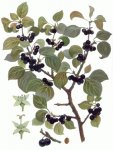Zoster laxative (buckthorn laxative) - rhaminus cathartica l.
Family Krushinovye - Rhamnaceae
Botanical characteristics. A strongly branchy, spreading shrub or small tree with a curved trunk covered with an almost black, rough cracked and peeling bark. The branches are opposite, almost always ending with thorns of stem origin. Annual shoots are covered with a yellowish-gray bark. Leaves opposite, less common. On plants that already have fruits, the leaves are collected in bundles, bright green on top, light and naked or thinly pubescent from below, in shape from elliptical to rounded with a pointed or blunt tip. The flowers are white. Fruit globular, drupe, bluish-black, shiny. Blossoms in May - June, the fruits ripen in August - September, stay on the plant for a long time.
Spread. It grows in the southern regions of the European part of the country, in Western Siberia, and in some parts of Central Asia. Prefers dry edges of deciduous and mixed forests, southern slopes of hills and river banks.
Used parts of the plant. Medicinal raw materials are fruits, leaves, bark, flowers, less often stems, collected in the usual way.
Chemical composition. Fruits contain carbohydrates and related compounds, organic acids, anthraquinones: glucofragulin, frangulin, emodin, sesterin; Flavonoids: rhamnocitrin, xanthormnnin, ramnetin, kaempferol, quercetin.
The bark contains carbohydrates, organic acids, essential oil, carotenoids, alkaloids, tannins, flavonoids, aromatic compounds, anthraquinones: chrysofanol, franguromodine, frangulozide, ramnocatartine; Higher fatty acids. Leaves contain vitamins; Seeds - fatty oil.
Application. Fruits are included in the domestic pharmacopoeia. Decoction of fruits is a laxative. Fruits are part of laxative tea, complex charges for the treatment of chronic, atonic and spastic constipation, cracks in the rectum, and in the collection for the preparation of Zdrenko's medicine, which is used as an antitumor agent.
In medical practice, decoction and infusion of fruits are used for violations of intestinal motility, in women - in the climacteric period.
In the experiment, the extracts of the zoster show antibacterial activity against bacteria that cause decay, as well as phytopathogenic (pathogenic) bacteria. Fruits have a pronounced laxative effect with a long latent period; Collection - with chamomile flowers, valerian root and corn stigmas, promotes intestinal peristalsis, reduces fermentation and putrefaction processes, has a disinfectant, anti-inflammatory and analgesic effect.
In folk medicine the decoction of branches, leaves and fruits is used for stomach ulcers, ascites, gout, hypoacid gastritis, respiratory infections, hemorrhoids, intestinal atony, chronic habitual constipation, as an astringent, with chronic skin diseases, as wound healing; Alcohol tincture - with rheumatism; Fresh juice is a potent laxative and diuretic.
Preparation
- For broth take 10 g of fruit, pour 200 ml of boiling water, insist on a boiling water bath for 30 minutes, cool 10 minutes, without removing from the bath, filter. Take 1/3 cup at night.
- For infusion of 15 g of leaves pour 200 ml of boiling water, insist on a water bath for 15 minutes, cool for 45 minutes, filter. Take 1/3 cup at night.
- Tincture of the fruit is prepared on 70% alcohol at a rate of 1: 5, insist in a dark place for 10 days. Take 40 drops at night.
Contraindications. Not recommended for a tendency to diarrhea.




Comments
When commenting on, remember that the content and tone of your message can hurt the feelings of real people, show respect and tolerance to your interlocutors even if you do not share their opinion, your behavior in the conditions of freedom of expression and anonymity provided by the Internet, changes Not only virtual, but also the real world. All comments are hidden from the index, spam is controlled.